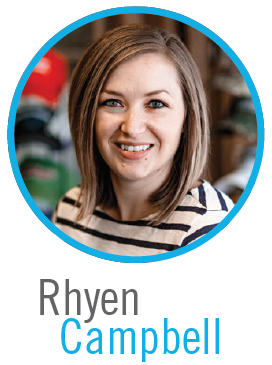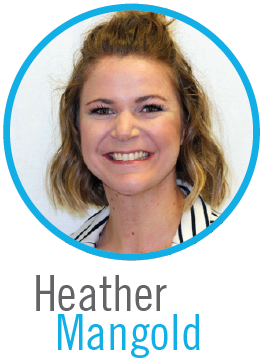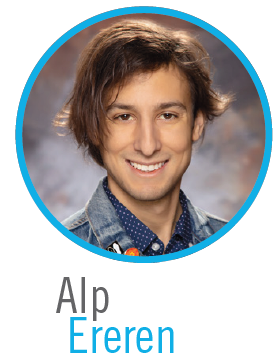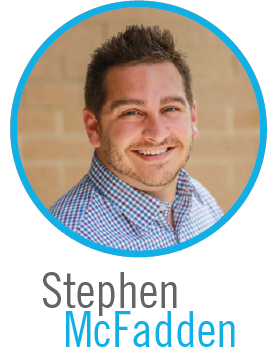Fresh Voices Of Promo

The future of promotional products lies largely in the hands of the next generation. In the coming years, it is up to the younger cohorts to harness, leverage and promote brands’ continued use of promo in marketing strategies to strengthen company presence and enhance ROI. It’s Millennials, Gen Z and those who follow who will educate businesses about the wide uses, returns and impressions associated with promo, and it is they who will continue market research into effective advertising, and how promo impacts the consumer experience.
Perhaps things will change in the future, but in this growing age of technology, promo continues to provide the touch (literally) and sensory experience that consumers look for. To prepare for ongoing success in future decades, suppliers, distributors and business services companies must be working now to pass their knowledge and experience into the waiting hands of the next generation.
SPARK, PPAI’s annual conference catering to young professionals in the promotional products industry, is designed to do just that. Providing networking opportunities, education about top-of-mind industry topics, discussions of issues facing the promo industry and opportunities to consider new strategies to strengthen one’s efficiency and accountability, this year’s SPARK, held July 17-19 in Charlotte, North Carolina, attracted 67 attendees, 39 who were first-timers.
Throughout the conference, industry-related questions, concerns and challenges were discussed from the perspective of young professionals, underscoring the need for companies (and their policies) to remain fluid and open to change in order to meet consumers’ and clients’ needs, and to remain relevant.
To better understand the perspective of some of the industry’s youngest professionals, PPB asked select SPARK attendees to answer three questions about their role in promo, and how their companies can better prepare for the future.
–––––––––––––––––––––––––––––––––––––––––––––––––––––––––––––––––––

Content strategist, Cap America, Inc., Fredericktown, Missouri
Years in the industry: 2
Years attending SPARK: first-time attendee
How would you describe your job in the industry to your peers? As a content strategist, I help Cap America’s marketing team create and deliver content through a multitude of platforms—social media, email, industry publications, etc.
How do you think companies can better attract and retain Millennial and Gen Z employees? I think a very important part of attracting and maintaining employees from the younger generation is allowing and even encouraging individualism—I’ve never met anyone my age or younger who was excited to wear a uniform. I love that this industry doesn’t turn its nose up at tattoos, piercings, bright hair colors and all the other ways that the younger generations have chosen to individualize ourselves. We embrace our differences and rather than being a distraction in the workplace, they are actually a way to bring us together and allow our creativity to develop and flow.
What do you think is the biggest issue facing the promotional products industry this year, and why? I think one of the biggest issues facing the industry is the recent tariffs. Prices are rising and because of that, demand is dwindling and many suppliers and distributors are really feeling the burn of this. For companies that are well-established enough to survive these turbulent times, the constant turmoil and uncertainty creates unwanted headaches and distracts us from other important responsibilities we would rather be focusing on. For smaller, less established companies, these tariffs could be the death of them.
–––––––––––––––––––––––––––––––––––––––––––––––––––––––––––––––––––

Sales specialist, Gill Studios, Inc., Lenexa, Kansas
Years in the industry: 1
Years attending SPARK: first-time attendee
How would you describe your job in the industry to your peers? I explain my job to my peers and friends as a sales rep for a promotional printing company. I always make sure to let them know the founder of my company actually invented the bumper sticker. This usually helps them understand what kind of printing we do—and it’s a fun trivia fact.
How do you think companies can better attract and retain Millennial and Gen Z employees? There are a few ways I know would have worked for me personally, as a young Millennial, including attending career fairs and being more visible online. However, there are two things we talked about in one of the SPARK workshops that I think would help attract younger employees to our industry. First, knowing that our industry, companies and cultures care about their social responsibility. For me, this was a deciding factor when I was picking which company I wanted to work for right out of college. It meant a lot to me that the company I worked for had a purpose and strived to make an impact on their community and/or environment. Along those same lines, the second aspect I know is very attractive to me, and I think a lot of Millennials would agree, is having the environmental impact of their business front of mind. This goes back to social responsibility, but I think it can also stand alone. I know my peers and I hold a lot of importance in products that are organic, reusable and green. So working for an industry that has the environment set as a priority is a huge selling point for a lot of people, and I think will continue to be the case, as society continues to move away from one-time-use products.
What do you think is the biggest issue facing the promotional products industry this year, and why? I think the biggest problem facing the promotional products industry, including my company as a supplier, is finding a way to provide the same quality of service and product in a shorter amount of time. We have continuously found that customers need their products faster and faster, which has been a trend forever. However, now it’s getting to the point of trying to find a same-day production solution, where just a couple of years ago the same kind of product would have had a 10-working day production. Technology is a great tool at our disposal, but it will take more than technology to find a resolution. It will take the industry working together as a whole, suppliers and distributors, to find ways to make the impossible possible.
–––––––––––––––––––––––––––––––––––––––––––––––––––––––––––––––––––

National sales representative, Raining Rose, Inc., Cedar Rapids, Iowa
Years in the industry: 1
Years attending SPARK: first-time attendee
How would you describe your job in the industry to your peers? My job as a national sales rep is to be an advocate to our customers. I am here to listen to their needs and maybe some obstacles they are facing, and help to develop a solution for them to present to their customers. As an advocate, we are well-versed in the markets they are working with so we can be a reliable resource when they need ideas/applications. I am not just a product pusher; I am an educator, a subject matter expert within our niche line and can deep dive into our products so our customers can feel confident with the products they are presenting. The best part of being an advocate is that I also learn from our customers from the stories and experiences they share, which then helps with building the relationship, as it isn’t one-sided. It also helps develop solutions for other customers facing similar issues.
How do you think companies can better attract and retain Millennial and Gen Z employees? I think companies first have to take a look at what is important to them. What are their core values? What is their purpose? Then develop a plan surrounding those core values and their needs. At times companies try to do what their neighbors are doing and it fails because they aren’t being true to themselves. From there, poll your employees, go to local colleges, maybe take a look at top local companies—ask them what they are looking for in an employer and what is needed to ensure they stay with a company. Dive into the information and then see what follows the core values/purpose, see what can be implemented immediately or what might need a long-term plan. Sometimes it is as easy as planning food days, or it could go to developing a voluntary time-off policy because there wasn’t one in place.
What do you think is the biggest issue facing the promotional products industry this year, and why? I think the biggest issue is sustainability and the environment. We have the issue with the ban on plastics and suppliers needing to find alternative resources, but we also have the issue where if a supplier or distributor isn’t willing to make the necessary changes to become more sustainable or develop a giveback program, customers will not use them. When an item is impactful beyond its use, it resonates with customers; there is a story behind it and they are more apt to use it.
–––––––––––––––––––––––––––––––––––––––––––––––––––––––––––––––––––

Marketing coordinator, Terry Town, San Diego, California
Years in the industry: 4
Years attending SPARK: 2
How would you describe your job in the industry to your peers? I usually have a blast trying to explain what it is we do, exactly, in our industry to my friends and outsiders who may have no idea that we even exist. I like to start off with what we specifically do at Terry Town, which is print and decorate custom beach towels, blankets and spa/home accessories. Then I move onto the bigger picture, where I like to explain the supplier-distributor relationship and how both are mutually beneficial to each other within our little promo ecosystem. As suppliers, we not only provide the products our distributors sell, but we supply the idea: a somewhat tangible message that can be utilized to bring together people from all walks of life. We like to offer more than just a promotional product. We offer success stories of strengthened relationships and a renewed sense of community. We’re all in this together and being able to foster new partnerships from supplier to distributor and distributor to end user is one of the best feelings in the world.
How do you think companies can better attract and retain Millennial and Gen Z employees? You’ve got to sell your company in the best light possible and follow through on those promises. Create a company culture that not only fosters hard-working individuals, but those who understand the nature and scope of how our industry operates as well. What we do is fun, and doesn’t have the stress and pressure that other industries may experience. Have a relaxed, but professional approach when it comes to attracting the next generation, and be open and willing to change. Being able to constantly ask, “How can we improve?” will get those new hires of the next gen thinking in the mindset of, “I’m here to shake things up.”
What do you think is the biggest issue facing the promotional products industry this year, and why? Right now we are in a weird limbo stage where the generation of those who helped shape the industry with a solid foundation [is working with] those who are just getting their feet wet right out of university. You’re going to have a push-pull factor from every direction in terms of what new products will make their way into our catalogs, how marketing will be affected by new technologies and how our entire industry will strive for social responsibility. But it’s not so much a “them against us;” the way I like to see it is more of a friendly challenge among colleagues who you still wouldn’t mind sharing a beer with after a long day on the trade-show floor. Striving for change is comforting. Complacency is scary.
–––––––––––––––––––––––––––––––––––––––––––––––––––––––––––––––––––

Senior account executive, SAGE, Addison, Texas
Years in the industry: 6
Years attending SPARK: 3 (second year in the SPARK workgroup)
How would you describe your job in the industry to your peers? I am a senior sales associate and account manager for the leading technology provider in the promotional products industry. I work with hundreds of promotional product distributors around the country to streamline their business processes using a combination of our tools, such as product research, digital presentations, order management, CRM and websites.
How do you think companies can better attract and retain Millennial and Gen Z employees? I think one of the best ways companies can attract and retain younger generational employees is acknowledging and empowering some of the values those generations hold in high regard. Salary and benefits, while important, are not the single-most important driving force. Employee engagement, giving them a voice with company decisions, corporate social responsibility, providing mentorship and growth opportunities and a willingness to embrace change, both technological and otherwise, are all factors that will influence the younger generations.
What do you think is the biggest issue facing the promotional products industry this year, and why? There are a number of issues that are facing our industry: globalization, generational workforce changes, tariffs, etc., but I feel the most prevalent is technological and the willingness to embrace pending advancements. Working as a technology provider provides me with a unique perspective, and the unfortunate truth is many distributors and suppliers (industry-wise and individually) are unwilling or uninformed to adapt to any sort of change. So much has already advanced in the last 10 years. Companies and individuals that continue to embrace those advancements, push the envelope and are willing to also confront failure, are the ones that are going to be successful. Those that continue to utilize the same old tools and techniques because it’s what has worked in the past, will see the industry, and business as a whole, pass them by.
–––––––––––––––––––––––––––––––––––––––––––––––––––––––––––––––––––

President, Perfect Promotions & More, Inc., Apex, North Carolina
Years in the industry: 11
Years attending SPARK: 3 (first year in the SPARK workgroup)
How would you describe your job in the industry to your peers? Most jobs you can explain in a few short words or with a title that everyone can relate to. With promotional products, that’s not the case, so I typically explain it through examples. My go-to is: “I work for a marketing agency where our marketing medium is product. We take client events, objectives and problems and turn them into fun product solutions.” I’ll then look around the room and say, “See those bags and that t-shirt over there? Those are examples of the types of products we can help you create for your events and marketing teams.” The on-the-fly examples always help explain what we do.
How do you think companies can better attract and retain Millennial and Gen Z employees? We have recently hired and are consulting to hire young employees into our company. It is clear that one of the biggest advantages you can provide the younger generation of talent is a clear career path or career path options. Most of this new generation will not be content with the same routine of work, day in and day out, and will look for other workplaces if they do not feel the work they are doing can help them advance in their careers and lives. We also pay attention to the company culture, providing fun team activities, incentives, fun work space—doing things like Spirit Week, holiday parties, community service projects, etc. Having fun in the place you spend the most time of your day is vital.
What do you think is the biggest issue facing the promotional products industry this year, and why? If it’s just for 2019, there has been no greater impact than tariffs. The increase in pricing and the uncertainty in costs have caused the workflow process to slow down. We have to double- and triple-check pricing for orders that have already been quoted and deal with the constant fluctuation of costs. I don’t think it will truly impact overall sales for us, but I do think it is changing the types of products that are purchased. For example, if the budget my client had was $10 per piece, their budget does not necessarily change with the tariffs, but the types of products they can purchase for $10 may adjust.
–––––––––––––––––––––––––––––––––––––––––––––––––––––––––––––––––––
Danielle Renda is associate editor of PPB.

